Core Amazon Web Services for Efficient Cloud Computing
 Muhammad Irfan
Muhammad Irfan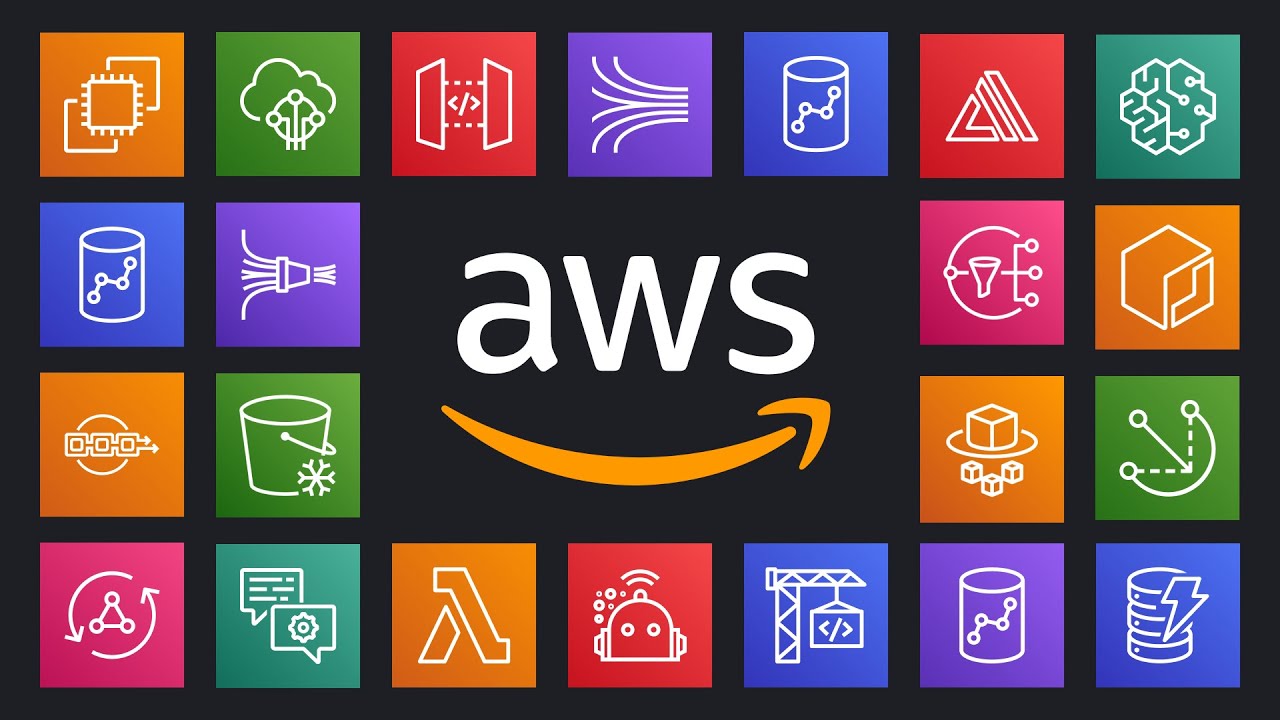
Overview of AWS Services 🌐
Amazon Web Services (AWS) is a comprehensive and broadly adopted cloud platform that offers over 200 fully featured services from data centers globally. These services provide the building blocks required to support various IT needs across a multitude of industries. AWS services range from compute power, storage options, networking and databases to analytics, machine learning, and security. Each service is designed to work together to provide a scalable and cost-effective solution, enabling businesses to move faster, lower IT costs, and scale applications. Here’s a quick look at some of the most popular AWS services! 🚀
1. Compute Services
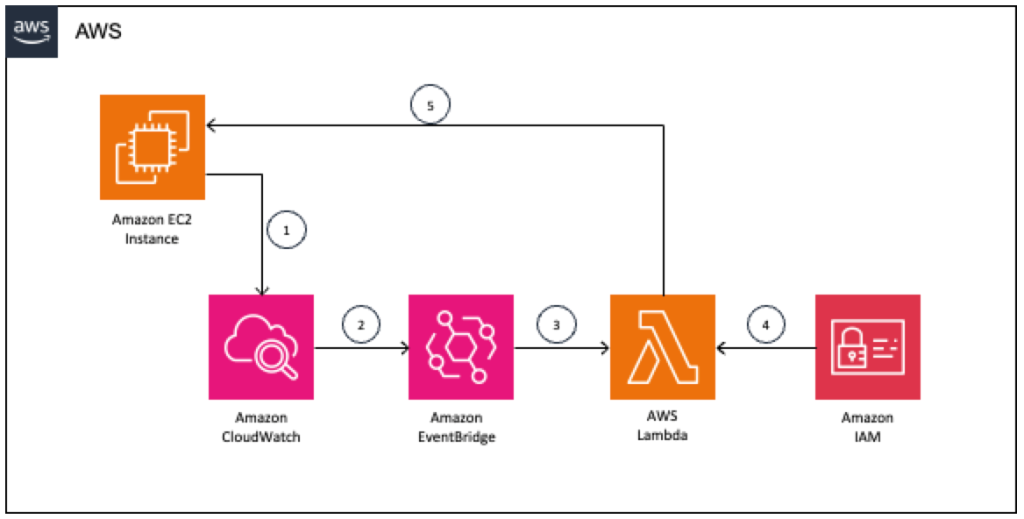
1.1 EC2 (Elastic Compute Cloud)☁️
Elastic Compute Cloud (EC2) is a central part of Amazon's cloud computing platform, Amazon Web Services (AWS). It allows users to rent virtual computers on which they can run their own computer applications. EC2 enables scalable deployment of applications by providing a web service through which a user can boot an Amazon Machine Image to configure a virtual machine, known as an "instance". This service offers a variety of instance types, which can be tailored to specific workload requirements and is designed to make web-scale cloud computing easier for developers. 📈
1.2 Lambda ⚡
AWS Lambda is a serverless computing service that allows to run code without provisioning or managing servers. It automatically manages the compute resources, executing code only when needed and scaling automatically, which means that pay only for the compute time as consume. This makes Lambda an ideal solution for applications that require the ability to scale up rapidly and scale down to zero when not in demand. With support for multiple programming languages and integration with various AWS services, Lambda facilitates a wide range of serverless applications, from web and mobile backends to event-driven data processing. Perfect for building applications quickly! 🛠️
1.3 ECS (Elastic Container Service) 📦
Amazon Web Services (AWS) offers a robust container orchestration service called Amazon Elastic Container Service (ECS). This fully managed service facilitates the deployment, management, and scaling of containerized applications. ECS is deeply integrated with the AWS ecosystem, allowing for seamless operation of containers both in the cloud and on-premises with ECS Anywhere. It's designed to provide a secure, reliable, and scalable environment for running containers, with the flexibility to use either AWS Fargate for serverless operation or EC2 instances for more control over the infrastructure. ECS simplifies the process of managing containers at scale, making it an essential tool for modern application development.
2. Storage Services
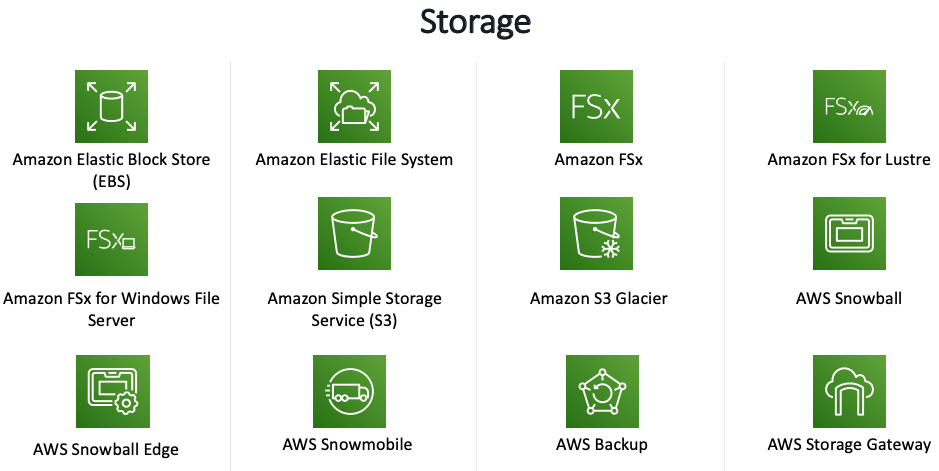
2.1 S3 (Simple Storage Service) 📁:
Amazon Web Services (AWS) offers a robust cloud storage solution known as Amazon Simple Storage Service (Amazon S3). It provides industry-leading scalability, data availability, security, and performance for customers of all sizes across various industries. With Amazon S3, users can store and retrieve any amount of data from anywhere, making it ideal for a wide range of applications, from data lakes to mobile apps. The service is known for its durability and availability, boasting an architecture designed to deliver 99.999999999% data durability and 99.99% availability. Additionally, Amazon S3 features a range of storage classes and management features, allowing users to optimize costs and organize data effectively. It’s great for backup, archiving, and big data analytics! 📊
2.2 EBS (Elastic Block Store) 🗄️
Amazon Elastic Block Store (EBS) is a high-performance block storage service designed for use with Amazon Elastic Compute Cloud (EC2) instances. It offers scalable storage solutions with multiple volume types to cater to different workload requirements, whether they are I/O intensive or throughput oriented. EBS volumes are easy to create, manage, and scale, providing a reliable way to store persistent data with features like point-in-time snapshots for backup and recovery. Moreover, EBS ensures data protection through encryption and maintains high availability and durability, making it a vital component for cloud-based applications and services.
2.3 Glacier 🧊
Amazon Glacier, the secure and durable cloud storage service, is pivotal for data archiving and long-term backup. As businesses evolve, trending keywords like "data lifecycle management," "cost-effective storage solutions," and "secure data encryption" have become increasingly associated with Amazon Glacier. This service is renowned for its ability to scale with growing data needs while ensuring compliance with regulatory requirements. By leveraging Amazon Glacier, organizations can optimize their storage costs and enhance data security, making it a cornerstone for modern data management strategies.
3. Database Services
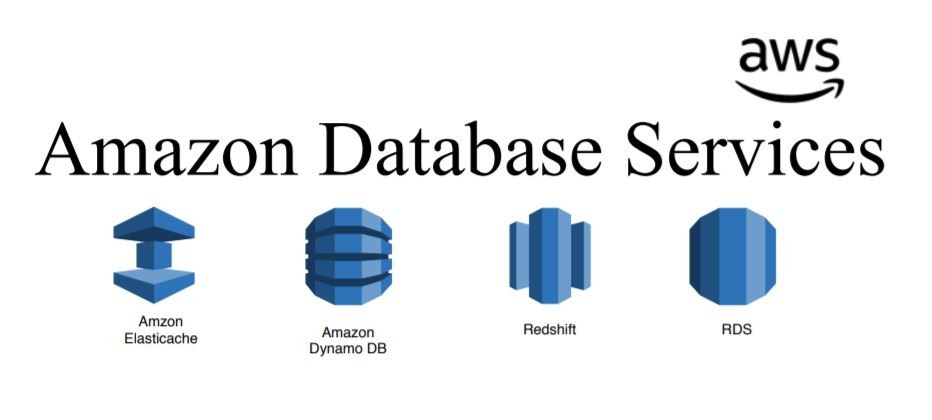
3.1 RDS (Relational Database Service) 🗄️
Amazon Web Services' Relational Database Service (AWS RDS) is a comprehensive cloud-based solution for database management, designed to simplify the setup, operation, and scaling of relational databases. It supports a variety of database engines, including MySQL, PostgreSQL, MariaDB, Oracle, and SQL Server, catering to a wide range of applications and use cases. AWS RDS stands out for its automated backups, patching, and multi-AZ deployments, ensuring high availability and data durability. With the integration of AWS Identity and Access Management (IAM), it also offers robust security features, making it a reliable choice for enterprises looking to optimize their database operations in the cloud.
3.2 DynamoDB ⚡
Amazon Web Services' DynamoDB is a fully managed NoSQL database service renowned for its fast and predictable performance, as well as its seamless scalability. As a serverless database, DynamoDB allows for the storage and retrieval of any amount of data, catering to a wide range of applications from mobile apps to gaming. It's designed to handle large-scale, high-traffic applications, providing built-in security, backup and restore, and in-memory caching. To optimize for cost and performance, it's crucial to understand and implement best practices, such as efficient query design and understanding reserved keywords to avoid common pitfalls.
3.3 Redshift 📊
Amazon Web Services' Redshift is a fully managed, petabyte-scale data warehouse service that has become an essential tool for data analysis. With its columnar storage and automatic data compression, Redshift enhances query performance, making it a popular choice for handling large-scale data workloads. Recent updates have focused on ease of use, with features like Redshift Serverless simplifying operations for a wide range of users. For those looking to optimize their use of Redshift, best practices suggest avoiding excessive use of wildcards in queries to maintain system performance.
4. Networking Services

4.1 VPC (Virtual Private Cloud) 🌐
Virtual Private Cloud (VPC) is a cornerstone of cloud networking, offering a wealth of features for enhancing security, connectivity, and control within the cloud environment. AWS VPC include isolated networking, flexible IP addressing, and advanced security measures like security groups and network ACLs. Additionally, VPC peering and AWS Transit Gateway are gaining traction as they facilitate seamless interconnectivity between multiple VPCs, optimizing operational efficiency and network management. With AWS VPC, businesses can leverage a scalable infrastructure that supports a wide range of applications and services, ensuring a secure and resilient virtual network that aligns with their specific needs.
4.2 Route 53 📡
AWS Route 53 is a highly available and scalable cloud DNS web service that plays a crucial role in managing internet traffic for users worldwide. Recent updates have introduced advanced features like IAM policy conditions for fine-grained access control and enhanced VPC permissions, ensuring more secure and efficient domain management. With its robust set of routing policies, Route 53 effectively directs user requests to the appropriate endpoints, whether they're AWS resources or external services, optimizing performance and availability. The service's integration with AWS CLI and Tag Editor simplifies the process of applying tags for resource management and cost tracking. As cloud computing continues to evolve, AWS Route 53 remains at the forefront, offering innovative solutions to meet the dynamic needs of today's digital landscape. It offers scalable DNS web service for reliable domain registration and routing with health checks.
4.3 CloudFront 🚀
Amazon CloudFront is a content delivery network (CDN) service provided by Amazon Web Services (AWS) that accelerates the delivery of websites, APIs, content, and other web resources. It achieves this by distributing content closer to users through a global network of edge locations. When a user requests content from CloudFront, the service routes the request to the nearest edge location, resulting in reduced latency and faster load times. CloudFront also offers a range of security features, including SSL/TLS encryption and AWS Shield for DDoS protection, ensuring that content is securely delivered.
5. Security and Identity Services
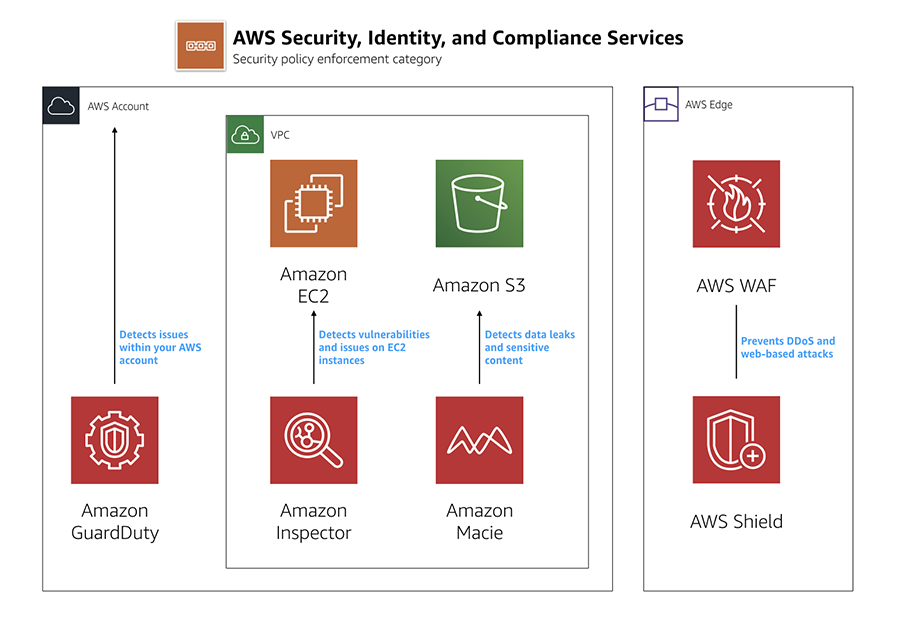
5.1 IAM (Identity and Access Management) 🔐
Amazon Identity and Access Management (IAM) is a robust web service that allows organizations to manage users and user permissions in AWS securely. With IAM, we can create and manage AWS users and groups, and use permissions to allow and deny their access to AWS resources. IAM is essential for managing the security of for AWS environment, enabling us to establish granular control over who can access what in AWS ecosystem. It supports identity federation, allowing for single sign-on and thus simplifying access management across multiple AWS services and resources.
5.2 Shield 🛡️
AWS Shield is a managed Distributed Denial of Service (DDoS) protection service provided by Amazon Web Services (AWS). It offers automatic detection and mitigation of DDoS attacks, ensuring that applications remain available and responsive. AWS Shield comes in two tiers: Standard and Advanced, with the latter providing additional protection features and support options.
5.3 WAF (Web Application Firewall) 🕵️
AWS Web Application Firewall (WAF) is a powerful cloud-based service designed to protect web applications from common web exploits that could affect application availability, compromise security, or consume excessive resources. AWS WAF allows users to create customizable web security rules that control bot traffic and block common attack patterns, such as SQL injection and cross-site scripting (XSS). With AWS WAF, web traffic can be filtered, prevent account takeover fraud, and administer security rules through APIs, providing a robust security solution for modern web applications.
6. Machine Learning Services

6.1 SageMaker 🤖
Amazon SageMaker is a fully managed service that provides an integrated platform to build, train, and deploy machine learning models. With a broad set of capabilities, SageMaker enables data scientists and developers to streamline the creation and deployment of machine learning models. It offers a high-performance, low-cost infrastructure with a variety of tools such as notebooks, debuggers, and pipelines, facilitating a more efficient machine learning workflow. SageMaker also supports a wide range of machine learning use cases, from predictive analytics to deep learning, making it a versatile tool in the field of artificial intelligence.
6.2 Rekognition 🖼️
Amazon Rekognition is a cloud-based service that provides advanced image and video analysis capabilities. It utilizes deep learning technology to identify objects, people, text, scenes, and activities in images and videos, making it easy to add computer vision features to applications without the need for machine learning expertise. With its wide range of features, including facial analysis and unsafe content detection, Amazon Rekognition enables various use cases from media analysis to user verification, enhancing the capabilities of modern applications.
6.3 Comprehend 📚
Amazon Comprehend is a cloud-based Natural Language Processing (NLP) service provided by AWS, designed to uncover insights and relationships in text. Utilizing machine learning, it can analyze a vast array of documents, from customer support tickets to social media feeds, extracting key phrases, sentiment, language, and entities. This service simplifies the processing of large volumes of text, enabling businesses to enhance customer experience, secure sensitive data, and streamline document workflows. With no prior machine learning expertise required, users can easily integrate Amazon Comprehend into their applications to leverage its powerful text analysis capabilities.
7. Conclusion

Amazon Web Services (AWS) provides a comprehensive cloud platform with over 200 services globally, enabling businesses to scale, lower IT costs, and enhance application performance. Key services include compute (EC2, Lambda, ECS), storage (S3, EBS, Glacier), databases (RDS, DynamoDB, Redshift), networking (VPC, Route 53, CloudFront), security (IAM, Shield, WAF), and machine learning (SageMaker, Rekognition, Comprehend). These services cater to various IT needs, ensuring scalability, security, and cost-efficiency for diverse applications and industries. By leveraging these services, businesses can enhance efficiency, scalability, and innovation. Whether you’re a startup or an enterprise, AWS has solutions that can help you thrive in the cloud! ☁️✨
Subscribe to my newsletter
Read articles from Muhammad Irfan directly inside your inbox. Subscribe to the newsletter, and don't miss out.
Written by

Muhammad Irfan
Muhammad Irfan
I am passionate about the transformative power of Linux, DevOps, and cloud technologies. With a background in system administration, I’m on a journey to master cloud infrastructure, automation, and containerization. On my GitHub, you’ll find projects where I explore automation, AWS, CI/CD, and scripting to solve real-world problems. 📚 Current Focus: Enhancing my expertise in Linux systems, AWS, and scripting. Here, I share insights and experiences from my hands-on projects to help and inspire fellow tech enthusiasts.